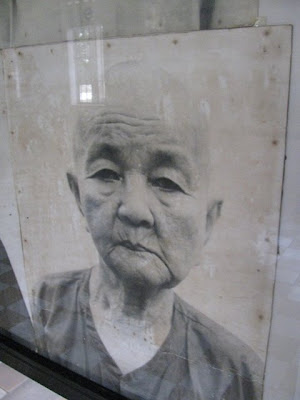This is a terrible place, a school turned prison, an ochre coloured hell.

This is the Tuol Sleng Prison Musuem. I am not going to give you a lot of carefully researched facts. I am not even going to spell check. This all comes right from my instant reactions after visiting the notorious prison in Phnom Penh, Cambodia.

The Khmer Rouge was the most brutal political party in history. No one on this planet has ever dreamed, ever fathomed of such rage carried out against their own people. Long story short – after decades of colonial occupation by snooty France (“we will lift these heathens from ignorance and also make them our slaves!”) invasion by the brutal, rapey Japanese and relentless bombing during the Vietnam War by the Americans, Cambodia was left smoking, blackened and wounded in a way that made the agrarian Maoist communism promised by “Brother Number 1” Pol Pot and his “Red Cambodians” (Khmer Rouge) sound very attractive.
Heavily influenced by China's Gang of 4, The Khmer Rouge distrusted all things intellectual and capitalist, which they lumped into the same category. As they took power in 1975, they emptied the cities - hotbeds of useless knowledge - of Cambodia in days – elderly women, babies, the disabled, the lepers, everyone was expected to march out any city of size and head to the countryside. Three million people had to leave Phnom Penh alone (the population is now in 2009 is only 1.5 million.). Once there, everyone had to pick up a tool and begin farming the newly collectivized farms, all land having been seized by the government. City people were branded as evil, as were doctors, Buddhist monks, Catholics, Indians, Muslims, Intellectuals and anyone deemed counter-revolutionary.
You are an 80 year old woman. The doorbell rings. Outside there are men with guns demanding that you leave your apartment in Phnom Penh, where you have lived all your life, and head to the countryside. You are confused and tired and scared and you protest. And then they bayonet you in front of your neighbours for resisting, not wanting to waste expensive bullets on an “Old Person.”

Old People was the term given to anyone who lived in a city. People who lived in the country were called New People. Wealthy women from the cities frantically dirtied their soft hands, because in this new world you wanted to be a New Person, and no one could know that you were educated. Days after marching people out of the cities - the killing began, and didn't stop for 4 years.
Can I mention that this happened in 1975 – a few years before we were all born? Can I mention that we in the West knew that this was happening but refused to get involved in another potential Southeast Asian quagmire? WE KNEW THIS TIME about the mass graves and the torture and the genocide committed not by “others” but the the same people against one another. We knew.

Famine and exhaustion killed many. The Khmer Rouge exported food as the locals starved, all in a false show of Maoist glory for the West to see. Children were orphaned and abandoned, starving to death in plain view of pork-fattened Khmer combatants. Do you speak English? Death. Do you know too much about science? Death. Do you wear eyeglasses? Death.
Currency was outlawed, and schools and hospitals (bastions of the educated) were closed – and prisons opened in their place. Tuol Sleng was the most notorious. Many peasants were killed in this time period – some estimate half of the population of Cambodia – but anyone suspected to have ties to any resistance or the Vietnamese were jailed and tortured and killed.
Bullets were in short supply so children were bludgeoned to death with hammers.
People were beheaded with sharp, stiff banana leaves.
And we wandered, scared and upset-stomached, through halls of the high school that housed 20,000 prisoners and only saw 17 emerge alive, we were greeted by the faces of the dead. The Khmer kept meticulous records of their prisoners – much in the way of the Nazis – black and white photos of the agitators line the walls, numbers pinned to their chests. Classrooms were transformed into torture chambers. Small rooms had been bricked up to make even smaller cells. Windows were decorated with barbed wire, walls studded with chains. As moans quietly escaped my throat, Sean turned pale, and more leg cuffs loomed in our vision. I have feared ghosts and supernatural things only a few times in my life, and this was genuinely one of them.

In the Third Building, starved and bug bitten people stared at me from the walls, cheeks hollowed and eyes bulging. Old women with proud eyes. Children with terrified eyes. Men with shamed eyes. If you were Pol Pot, these people were threats to your revolution.
As I took a photo of the blackboard covered in mugshots, on the display screen 7 little facial recognition boxes popped up. My camera recognized what the Khmer Rouge didn't.
I don't know what else to say.















1 comment:
The endless amount of face shots in that room makes it a very sober place to be
Post a Comment